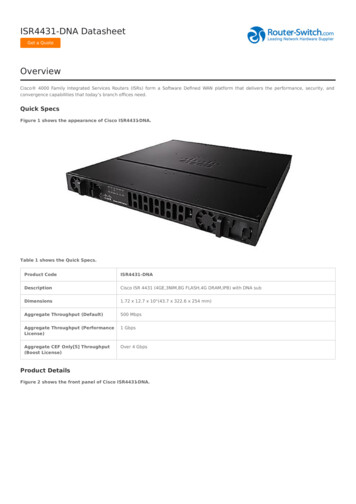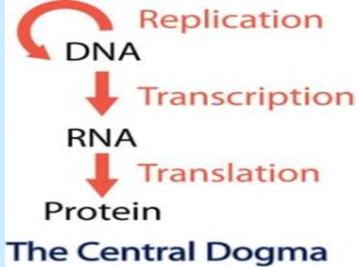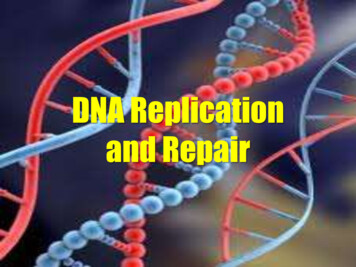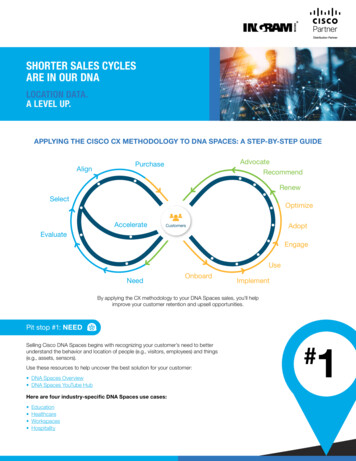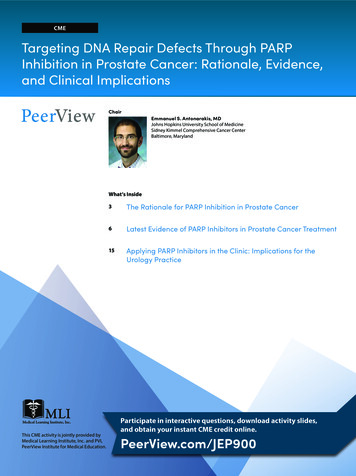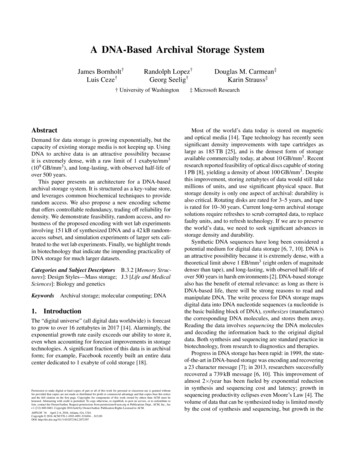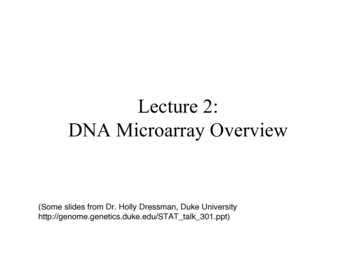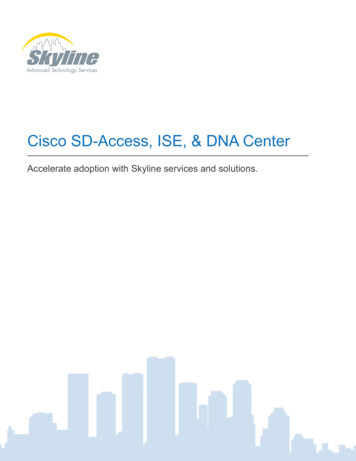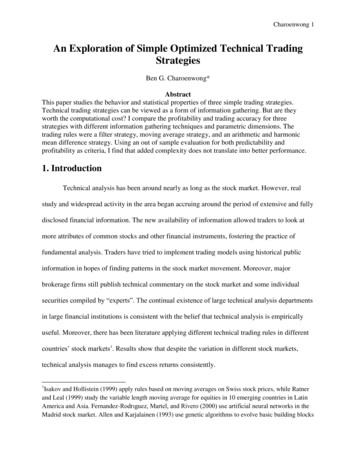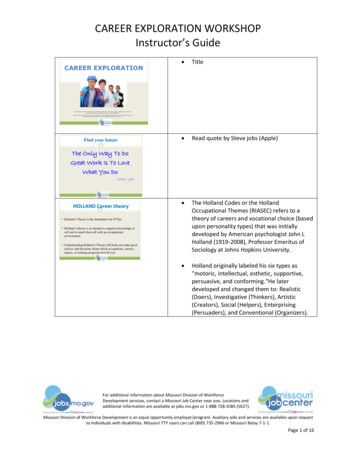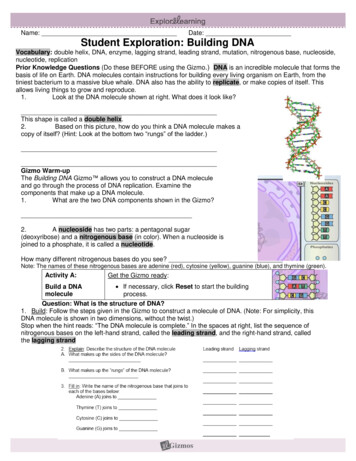
Transcription
Name:Date:Student Exploration: Building DNAVocabulary: double helix, DNA, enzyme, lagging strand, leading strand, mutation, nitrogenous base, nucleoside,nucleotide, replicationPrior Knowledge Questions (Do these BEFORE using the Gizmo.) DNA is an incredible molecule that forms thebasis of life on Earth. DNA molecules contain instructions for building every living organism on Earth, from thetiniest bacterium to a massive blue whale. DNA also has the ability to replicate, or make copies of itself. Thisallows living things to grow and reproduce.1.Look at the DNA molecule shown at right. What does it look like?This shape is called a double helix.2.Based on this picture, how do you think a DNA molecule makes acopy of itself? (Hint: Look at the bottom two “rungs” of the ladder.)Gizmo Warm-upThe Building DNA Gizmo allows you to construct a DNA moleculeand go through the process of DNA replication. Examine thecomponents that make up a DNA molecule.1.What are the two DNA components shown in the Gizmo?2.A nucleoside has two parts: a pentagonal sugar(deoxyribose) and a nitrogenous base (in color). When a nucleoside isjoined to a phosphate, it is called a nucleotide.How many different nitrogenous bases do you see?Note: The names of these nitrogenous bases are adenine (red), cytosine (yellow), guanine (blue), and thymine (green).Activity A:Get the Gizmo ready: If necessary, click Reset to start the buildingBuild a DNAmoleculeprocess.Question: What is the structure of DNA?1. Build: Follow the steps given in the Gizmo to construct a molecule of DNA. (Note: For simplicity, thisDNA molecule is shown in two dimensions, without the twist.)Stop when the hint reads: “The DNA molecule is complete.” In the spaces at right, list the sequence ofnitrogenous bases on the left-hand strand, called the leading strand, and the right-hand strand, calledthe lagging strand
Student Exploration: RNA and Protein SynthesisVocabulary: amino acid, anticodon, codon, messenger RNA, nucleotide, ribosome, RNA, RNA polymerase,transcription, transfer RNA, translationPrior Knowledge Questions (Do these BEFORE using the Gizmo.)3. Suppose you want to design and build a house. How would you communicate your design plans with theconstruction crew that would work on the house?4. Cells build large, complicated molecules, such as proteins. What do you think cells use as their “designplans” for proteins?Gizmo Warm-upJust as a construction crew uses blueprints to build a house, a cell uses DNAas plans for building proteins. In addition to DNA, another nucleic acid, calledRNA, is involved in making proteins. In the RNA and Protein SynthesisGizmo , you will use both DNA and RNA to construct a protein out of aminoacids.3. DNA is composed of the bases adenine (A), cytosine (C), guanine (G), andthymine (T). RNA is composed of adenine, cytosine, guanine, and uracil(U).Look at the SIMULATION pane. Is the shown molecule DNA or RNA? Howdo you know?4. RNA polymerase is a type of enzyme. Enzymes help chemical reactions occur quickly. Click the Releaseenzyme button, and describe what happens.Activity A:TranscriptionGet the Gizmo ready: If necessary, click Release enzyme.Introduction: The first stage of building a protein involves a process known as transcription. In transcription,a segment of DNA serves as a template to produce a complementary strand of RNA. This complementarystrand is called messenger RNA, or mRNA.Question: What occurs during transcription?1. Experiment: Like DNA, RNA follows base-pairing rules. Experiment to find which RNA nucleotide on theright side of the Gizmo will successfully pair with the thymine at the top of the template strand of DNA.(NOTE: The DNA on the right side is the template strand.)Which RNA base bonded with the thymine?2. Experiment: The next three bases on the DNA template strand are adenine, cytosine, andguanine. Use the Gizmo to answer the following questions:A. Which RNA base bonds with adenine?B. Which RNA base bonds with cytosine?C. Which RNA base bonds with guanine?3. Analyze: In molecules of RNA, uracil takes the place of the DNA base .
4. Build: Continue building the molecule of mRNA until you have used all of the RNAnucleotides. What is the nucleotide sequence of the mRNA strand you built?5. Apply: Suppose a template strand of DNA had the following sequence:T A CG G AT A AC T AC C GG G TA T TWhat would be the complementary strand of mRNA?C A A6. Predict: How would a change in the sequence of nucleotides in a DNA molecule affect themRNA transcribed from the DNA molecule?Activity B:Get the Gizmo ready:Translation Once the mRNA strand has been built, click Continue.Introduction: After a strand of mRNA has been built, the strand exits the cell’s nucleus. Thesecond stage of protein synthesis, called translation, occurs next. During translation, the strandof mRNA is used to build a chain of amino acids.Question: What occurs during translation?1. Observe: Examine the strand of mRNA onthe SIMULATION pane. Every group ofthree bases of mRNA is called a codon.In the table at right, list the nitrogen basesin each codon. (Hint: Start from the top ofthe strand and read down.) The first mRNAcodon is called the universal start codon.CodonmRNA bases12342. Predict: Translation starts when a ribosome (the purple structure on the SIMULATIONpane) binds to a strand of mRNA. Transfer RNA, or tRNA, begins bringing amino acids intothe ribosome. Each tRNA molecule carries only one kind of amino acid. This amino acid isdetermined by the tRNA’s anticodon, a set of three unpaired bases.Which anticodon do you think would attach to the mRNA’s start codon?Use the Gizmo to check your answer.3. Observe: Place the next two anticodons on the mRNA strand. What happens?As each tRNA molecule binds to the mRNA, the ribosome joins the amino acid carried bythe tRNA to the growing amino acid chain.4. Describe: UAG (as well as UAA and UGA) is an example of a stop codon. Molecules calledrelease factors bind to stop codons. Place the release factor on the mRNA molecule.
What happens?Click Continue. Your protein is now complete. Most actual proteins consist of sequences ofhundreds of amino acids.5. Infer: Why do you think stop and start codon signals are necessary for protein synthesis?6. Translate: Codons code for different amino acids. Examine the codon chart below. Theamino acid coded for by a specific mRNA codon can be determined by finding the first baseof the codon along the left side of the table, the second base along the top of the table, andthe third base along the right side of the table.What amino acids do the following codons code for?AUG: CUG: ACC: UAG:7. Apply: Suppose you wanted a protein that consists of the amino acid sequence methionine,asparagine, valine, and histidine. Give an mRNA sequence that would code for this protein.8. Extend your thinking: Sometimes errors occur during transcription or translation. Examinethe codon chart above. Each amino acid is coded for by several different codons.How might this offset transcription or translation errors?
DNA Coloring - Transcription & TranslationTranscription RNA, Ribonucleic Acid is very similar to DNA. RNA normally exists as a single strand (andnot the double stranded double helix of DNA). It contains the same bases, adenine, guanine and cytosine.However, there is no thymine found in RNA, instead there is a similar compound called uracil.Transcription is the process by which RNA is made from DNA. It occurs in the nucleus. Label the box with the x init near the nucleus with the word TRANSCRIPTION and proceed to color the bases according to the key belowThymine orangeAdenine dark greenGuanine purpleCytosine yellowUracil brownColor the strand of DNA dark blue (D) and the strand of RNA light blue (R). Color the nuclear membrane (E) gray.Draw nuclear pores in the nuclear envelope.Translation Translation occurs in the cytoplasm, specifically on the ribosomes. The mRNA made in thenucleus travels out to the ribosome to carry the "message" of the DNA. Here at the ribosome, that massage willbe translated into an amino acid sequence. Color the ribosome light green (Y) and note how the RNA strandthreads through the ribsosome like a tape measure and the amino acids are assembled. The RNA strand in thetranslation area should also be colored light blue, as it was colored in the nucleus.Label the box with the X in the translation area with the word TRANSLATION.Important to the process of translation is another type of RNA called Transfer RNA (F) which function to carry theamino acids to the site of protein synthesis on the ribosome. Color the tRNA red.A tRNA has two important areas. The anticodon, which matches the codon on the RNA strand. Remember thatcodons are sets of three bases that code for a single amino acid. Make sure you color the bases of the anticodonthe same color as the bases on your DNA and RNA strand - they are the same molecules!At the top of the tRNA is the amino acids. There are twenty amino acids that can combine together to formproteins of all kinds, these are the proteins that are used in life processes. When you digest your food forinstance, you are using enzymes that were originally proteins that were assembled from amino acids. Each tRNAhas a different amino acid which link together like box cars on a train. Color all the amino acids (M) pink.Questions:1. How many different kinds of bases can be found on DNA2. What base is found on RNA but not on DNA?3. How many bases are in a codon? In an anticodon?4. How many amino acids are attached to a single transfer RNA?5. Transcription occurs in the ; translation occurs in the .6. The process of making RNA from DNA is called and itoccurs in the
7. The process of assembling a protein from RNA is calledand it occurs in theDraw and Label 3 places where you might see deoxyribose with a purpleDraw and Label 3 places where you might see ribose with a pinkDraw and Label 3 places where you might see phosphate group with a gold
Student Exploration: Building DNA Vocabulary: double helix, DNA, enzyme, lagging strand, leading strand, mutation, nitrogenous base, nucleoside, nucleotide, replication Prior Knowledge Questions (Do these BEFORE using the Gizmo.) DNA is an incredible molecule that forms the basis of life on Earth. DNA molecules contain instructions for building every living organism on Earth, from the tiniest .File Size: 348KBPage Count: 7
